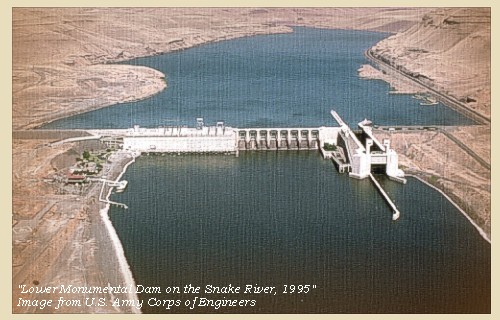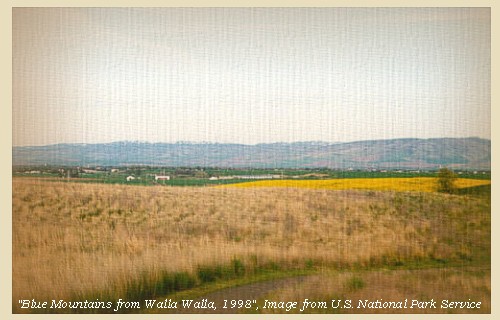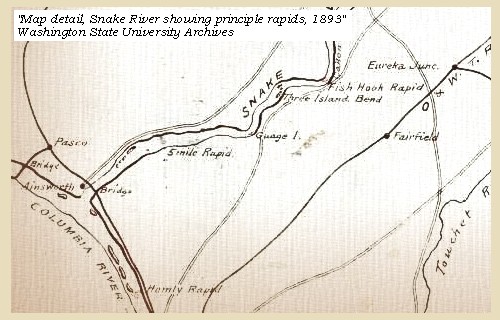The Volcanoes of
Lewis and Clark
Lewis and Clark
|
October 14 - 15, 1805 On the Snake River - Ayers Junction to Fish Hook Rapids |
|
Home
The Volcanoes of Lewis and Clark Map of the Journey Volcanoes, Basalt Plateaus, Major Rivers, etc. The Volcanoes Mount Adams, Mount Hood, Mount Jefferson, Mount Rainier, and Mount St. Helens CALENDAR of the Journey October 1805 to June 1806 Along the Journey Pacific Northwest Maps - Columbia River, Volcanoes, Flood Basalts, Missoula Floods, Geology, etc. The Corps of Discovery The Journey of Lewis and Clark About the Reference Materials The Journals, Biddle/Allen, DeVoto, Gass, Moulton, Topo Maps, and others USGS Lewis and Clark Links Links to USGS Websites highlighting the Lewis and Clark Journey Resources Publications Referenced and Websites Visited |
PREVIOUS
October 13 On the Snake, Texas Rapids to Ayers Junction |
October 14-15
On the Snake, Ayers Junction to Fish Hook Rapids Monumental Rock, Lower Monumental Dam and Lake West, Pine Tree Rapids, Blue Mountains, possible sighting of Mount Adams ???, Rattlesnake Flats and Fish Hook Rapids, Fishhook Park |
CONTINUE
October 16 Reaching the Columbia, Snake/Columbia Confluence |
|
To the Pacific - October 1805
On the Snake - Ayers Junction to Fish Hook Rapids |
| Lewis and Clark's camp of October 13, 1805 was approximately 13 miles downstream of the Palouse River, on the north bank of the Snake River, 6 miles downstream of present-day Ayers Junction, Washington. |
| Monday, October 14, 1805 |
| The wind was high from the southwest during the evening, and this morning it changed to the west, and the weather became very cold until about twelve o'clock, when it shifted to the southwest, and continued in that quarter during the rest of the day We set out early, and after passing some swift water, reached at two and a half miles It was situated on a point to the left, at some distance from the ascending country, very high and large, and resembling in its shape the hull of a ship. [Monumental Rock] |
| "... at 2 1/2 miles passed a remarkable rock verry large and resembling the hill of a Ship Situated on a Lard point at Some distance from the assending Countrey ..." [Clark, October 14, 1805] |
|
|
|
Monumental Rock:
Lewis and Clark called this large basalt rock formation "Ship Rock," because it resembled the hull of a ship. The Lewis and Clark name did not survive, replaced with a new name during the steamboat era on the Northwest rivers. Monumental Rock is located near the Monumental Rapids of the Snake River, and inspired the name for Lower Monumental Dam, one of the four dams on the lower section of the Snake River. -- Washington State Historical Society Website, 2002 |
| In 1969, construction was completed on the Lower Monumental Dam and Lock, spanning the Snake River at River Mile 42. Lake West, the reservoir behind Lower Monumental Dam, reaches nearly 30 miles upstream. |
| At five miles we passed a rapid; at eight another rapid, and a small island on the right, and at ten and a half a small island on the right. We halted a mile and a half below for the purpose of examining a much larger and more dangerous rapid than those we had yet passed. It is three miles in length, and very difficult to navigate. We had scarcely set out, when three of the canoes stuck fast in endeavouring to avoid the rocks in the channel; soon after in passing two small rocky islands, one of the canoes struck a rock, but was prevented from upsetting, and fortunately we all arrived safe at the lower end of the rapid. Here we dined, and then proceeded, and soon reached another rapid [Pine Tree Rapids] on both sides of the river, which was divided by an island. |
| As we were descending it one of the boats was driven crosswise against a rock in the middle of the current. The crew attempted to get her off, but the waves dashed over her, and she soon filled; they got out on the rock and held her above water with great exertion, till another canoe was unloaded and sent to her relief; but they could not prevent a great deal of her baggage from floating down the stream. ...... In order to diminish the loss as far as was in our power, we halted for the night on an island [at Pine Tree Rapids], and exposed every thing to dry. ...... Our journey was fifteen miles in length. |
| "... the country continues barron and broken in places &C ..." [Ordway, October 14, 1805] |
|
|
|
The Camp - October 14, 1805:
Lewis and Clark's camp of October 14, 1805, was on an island at the Pine Tree Rapids, just downstream from Burr Canyon. It is now inundated by Lake Sacajawea, the reservoir behind Ice Harbor Dam. |
| Tuesday, October 15, 1805 |
| The morning was fair, and being obliged to remain for the purpose of drying the baggage, we sent out the hunters to the plains, but they returned at ten o'clock, without having seen even the tracks of any large game, but brought in three geese and two ducks. The plains are waving, and as we walked in them, we could plainly discover a range of mountains [Blue Mountains] bearing southeast and northwest, becoming higher as they advanced towards the north, the nearest point bearing south about sixty miles from us. |
| "... a fair morning after a Cold night. Some frost this morning and Ice. Several hunters out Saw nothing Capt Lewis assended the hills & Saw Mountain a head bearing S. E. & N W. a high point to the west. Plain wavering. Set out at 3 oClock? ..." [Clark, October 15, 1805, first draft] |
| The "Mountain a head bearing S. E. & N W." are the Blue Mountains. However, could this "a high point to the west" be Mount Adams ??? ... Some Historians believe so, making this the earliest sighting Lewis and Clark had of the Cascade Range Volcanoes. |
| Our stores being sufficiently dry to be reloaded, and as we shall be obliged to stop for the purpose of making some celestial observations at the mouth of the river [Snake River], which cannot be at a great distance, we concluded to embark and complete the drying at that place: we therefore set out at two o'clock. |
| " ... This river in general is very handsome, except at the rapids, where it is risking both life and property to pass; and even these rapids, when the bare view or prospect is considered distinct from the advantages of navigation, may add to its beauty, by interposing variety and scenes of romantick grandeur where there is so much uniformity in the appearance of the country ..." [Gass, October 15, 1805] |
| For the first four miles we passed three islands, at the lower points of which were the same number of rapids, besides a fourth at a distance from them. During the next ten miles we passed eight islands and three more rapids, and reached a point of rocks on the left side. The islands were of various sizes, but were all composed of round stone and sand: the rapids were in many places difficult and dangerous to pass. About this place the country becomes lower than usual, the ground over the river not being higher than ninety or a hundred feet, and extending back into a waving plain. Soon after leaving this point of rocks, we entered a narrow channel formed by the projecting cliffs of the bank, which rise nearly perpendicular from the water. The river is not however rapid, but gentle and smooth during its confinement, which lasts for three miles, when it falls, or rather widens into a kind of basin nearly round, and without any perceptible current. |
| "... in the evening the countrey becomes lower not exceding 90 or 100 feet above the water and back is a wavering Plain on each Side, passed thro: narrows for 3 miles where the Clifts of rocks juted to the river on each Side compressing the water of the river through a narrow chanel; below which it widens into a kind of bason nearly round without any proceptiable current, at the lower part of this bason is a bad dificuelt and dangerous rapid to pass ..." [Clark, October 15, 1805] |
| "... Clifts of rocks 100 feet high. below which the river widens into a Bay nearly round. ..." [Clark, October 15, 1805] |
| After passing through this basin, we were joined by the three Indians who had piloted us through the rapids since we left the forks, and who in company with our two chiefs had gone before us. They had now halted here to warn us of a dangerous rapid [Fishhook Rapids], which begins at the lower point of the basin. As the day was too far spent to descend it, we determined to examine before we attempted it, and therefore landed near an island at the head of the rapid [Fishhook Rapids], and studied particularly all its narrow and difficult parts. The spot where we landed [Rattlesnake Flats, across from today's Fishhook Park] was an old fishing establishment, of which there yet remained the timbers of a house carefully raised on scaffolds to protect them against the spring tide. |
| Not being able to procure any other fuel, and the night being cold, we were again obliged to use the property of the Indians, who still remain in the plains hunting the antelope. Our progress was only twenty miles in consequence of the difficulty of passing the rapids. Our game consisted of two teal. |
| "... the country continues barron as usal. ..." [Ordway, October 15, 1805] |
|
|
|
The Camp - October 15, 1805:
Lewis and Clark's camp of October 15, 1805 was located at Rattlesnake Flats, on the right bank of the Snake River at the head of Fishhook Rapids. Fishhook Rapids today is under the waters of Lake Sacajawea. The camp was located directly across the Snake River from today's Fishhook Park. |
| Home | Previous | Continue |
If you have questions or comments please contact: GS-CVO-WEB@usgs.gov
June/July 2004, Lyn Topinka
The Volcanoes of Lewis and Clark Home Page | CVO Home Page














